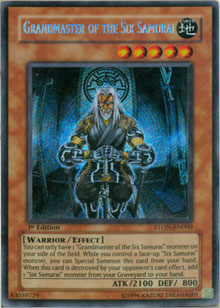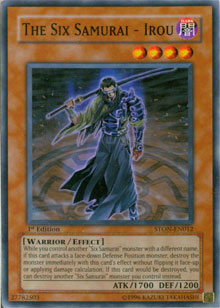
The Six Samurai were certainly a popular pull at the Strike of Neos Sneak Preview Event. As duelists made their way through the registration lines, the Grandmaster disappeared in a hurry. With those Grandmasters began the spark of fiery determination to build the best Six Samurai deck possible.
Building and using a good Six Samurai deck requires a solid understanding of how they function together on the field, how their effects can support the team, and how they can shield each other from fatal blows. This week, we examine these basic mechanics shared by the Six Samurai team.
Same Affiliation
 The Six Samurai function mainly as a team. On their own, they have only their ATK and DEF values to speak of. When a player constructs a deck with the Six Samurai, that player must decide if he or she wants to combine the efforts of the entire team or focus on specific members and their abilities. That player also needs to find a method of ensuring that members of the Six Samurai will find their way onto the field together.
The Six Samurai function mainly as a team. On their own, they have only their ATK and DEF values to speak of. When a player constructs a deck with the Six Samurai, that player must decide if he or she wants to combine the efforts of the entire team or focus on specific members and their abilities. That player also needs to find a method of ensuring that members of the Six Samurai will find their way onto the field together.
Each member of the team has an effect that includes a restriction that says, “While you control another Six Samurai monster with a different name . . .” This text tells you that you need to have more than one Six Samurai monster and that you need at least two with different names. You can have two copies of the same Six Samurai monster as long they’ve got a fellow teammate with a different name sharing your side of the field.
Suppose you have two face-up copies of The Six Samurai - Zanji on your side of the field. Right now, you have two Six Samurai monsters, but they both have the same name, so their main effect isn’t doing anything. When you summon The Six Samurai - Yaichi, the effects of each The Six Samurai - Zanji turn on and you are allowed to start using them. It doesn’t matter that you have two Six Samurai with the same name. As long as they’ve got a fellow teammate with a different name on the field, their effect will turn on. The effect of The Six Samurai - Yaichi turns on as well, allowing you to destroy one of your opponent’s set spell or trap cards.
This effect quirk is what makes Grandmaster of the Six Samurai such a tremendous addition to the team. The ability to normal summon a Six Samurai and follow it with a special summoned Grandmaster gets the Six Samurai effects rolling in a hurry by introducing two Six Samurai monsters with different names onto your side of the field. While the Grandmaster doesn’t really have a main effect on the field, his presence is a blessing to all the other Samurai that do.
One for the Team
The original six Six Samurai share one common effect:
“If this card would be destroyed, you can destroy another Six Samurai monster you control instead.”
This text isn’t limited to any one specific type of destruction and can be applied across a broad range of circumstances. Full understanding of what this text means will help you to recognize when you should use it.
This effect is meaningless when you only have one Six Samurai monster because one Six Samurai threatened with destruction needs to have another it can substitute. In addition, both Six Samurai involved in the exchange need to be face up on your side of the field. The exchange between the two is a one-for-one trade, with one Six Samurai taking the fall for the other.
It doesn’t even matter if the card effect destroying the Six Samurai is a targeted or non-targeted effect. This substitution effect is applied when the effect that will destroy your Six Samurai is resolved. The Six Samurai substitution effect doesn’t use the chain and cannot be chained to.
Example 1: Targeting a Samurai
 Jason has The Six Samurai - Irou and The Six Samurai - Yaichi face up on his side of the field. His opponent, Sarah, activates Tribute to the Doomed and selects Irou as the target. When the effect is resolved, Irou should be destroyed, but Jason can decide to destroy Yaichi instead. By doing so, Yaichi is destroyed and sent to the graveyard, while Irou remains on the field.
Jason has The Six Samurai - Irou and The Six Samurai - Yaichi face up on his side of the field. His opponent, Sarah, activates Tribute to the Doomed and selects Irou as the target. When the effect is resolved, Irou should be destroyed, but Jason can decide to destroy Yaichi instead. By doing so, Yaichi is destroyed and sent to the graveyard, while Irou remains on the field.
Targeted effects are fairly straightforward. You know who will be destroyed and how it is going to happen. When a non-targeting effect is involved, you will need to determine what to do when the effect is resolved.
Example 2: Non-Targeting a Samurai
Jason has The Six Samurai - Zanji and The Six Samurai - Nisashi face up on his side of the field. His opponent, Sarah, activates Smashing Ground.
When Smashing Ground is resolved and it is determined that The Six Samurai - Zanji should be destroyed because he has the highest DEF, Jason has the option to destroy The Six Samurai - Nisashi instead. By doing so, Nisashi is destroyed and sent to the graveyard, while Zanji remains on the field.
We Had a Team-Up . . .
Destruction in battle has its own way of being resolved that differs from destruction by card effects. When a Six Samurai monster you control is destroyed in battle, you can decide to destroy another Six Samurai monster you control. The monster you decide to substitute doesn’t leave the field right away. Instead it is sent to the graveyard at the same time a monster destroyed in battle normally goes to the graveyard.
Example: You were great
Jason has The Six Samurai - Irou and The Six Samurai - Kamon in face-up attack position. Sarah attacks The Six Samurai - Irou with Frostosaurus.
The Six Samurai - Irou is easily Dino-food, but with Irou’s effect, Kamon can valiantly sacrifice himself and suffer destruction instead. Irou is not destroyed and Kamon is destroyed by Irou’s effect.
By using one Six Samurai to take the fall for another, the attacked card is not even considered “destroyed” by game mechanics. Yes, that does sound strange, but if you happen to run into monsters with effects that trigger by successfully destroying a monster in battle, you will appreciate the distinction.
Take Elemental Hero Flame Wingman for example. Jaden’s signature monster usually dishes out quite a bit of punishment when his effect kicks in some burn damage based on the monster he destroyed in battle. When Jaden’s monster encounters a Six Samurai team, things don’t work quite so well. If one Six Samurai is destroyed to protect the Six Samurai getting pounded by the Elemental Hero Flame Wingman, the Six Samurai that would have been destroyed in battle is no longer treated as such. This means Elemental Hero Flame Wingman’s effect doesn’t generate any damage. By a twist of fate, he has “failed” to destroy a monster in battle.
Furthermore, the Six Samurai monster that was destroyed as a substitution is not considered to have been destroyed by battle. He was destroyed by the effect of his fellow Six Samurai. You will see that this plays a role in what happens when a Six Samurai is destroyed by a card effect as well.
Next week, we will continue this subject and look at what happens when multiple Six Samurai monsters are destroyed simultaneously. Until then, send all comments to Curtis@Metagame.com